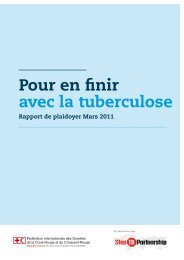Thailand - Stop TB Partnership
Thailand - Stop TB Partnership
Thailand - Stop TB Partnership
Create successful ePaper yourself
Turn your PDF publications into a flip-book with our unique Google optimized e-Paper software.
According to one AIDS activist, many people living with HIV/AIDS—who are often<br />
smear-negative—die from <strong>TB</strong> without ever being diagnosed with <strong>TB</strong> or treated for it. 60 Others<br />
assert that an overriding focus on achieving targets may result in insufficient attention to<br />
country-specific issues such as the need to strengthen health systems and improve the service<br />
delivery infrastructure. 61 However, many Thai <strong>TB</strong> experts consider the global <strong>TB</strong> targets<br />
critical in motivating government progress, and express confidence in the national capacity<br />
to achieve or exceed them. 62<br />
DOTS implementation<br />
We think of ARV [antiretroviral drug] distribution among people living<br />
with HIV/AIDS as a model. People living with HIV/AIDS become<br />
actively involved [in their own treatment]: they do home visit projects;<br />
they join committees at hospitals; they have a role in encouraging and<br />
supporting their fellow people living with HIV/AIDS to stick to treatment.<br />
This is the crucial role local communities have played in making AIDS<br />
programs successful [and] this . . . story could be replicated for <strong>TB</strong> patients.<br />
—Rev. Sanan Wutti, The Church of Christ in <strong>Thailand</strong> 63<br />
DOTS implementation is decentralized to the district and the subdistrict levels, the lowest units<br />
of management for <strong>TB</strong> control. District and provincial hospitals offer diagnostic services, and<br />
house <strong>TB</strong> clinics that register and track the treatment of all patients. The 19 Zonal <strong>TB</strong> centers<br />
coordinate the activities of the provincial and district hospitals and the subdistrict health<br />
centers and provide technical supervision and drug supplies.<br />
According to NTP guidelines, all <strong>TB</strong> patients can choose to receive DOT from a<br />
government health care worker, a village health volunteer, or a family member. One major<br />
study found that DOT was most effective when administered by professional health care<br />
workers, but that high turnover rates limited the efficacy and accessibility of this option.<br />
On the other hand, DOT administered by family members frequently deviated from NTP<br />
guidelines, which is reflected in higher levels of noncompliance with treatment. 64 This may<br />
be due to family members’ lack of understanding of the treatment protocol and the complexities<br />
of interpersonal dynamics. 65 However, according to some observers, since district<br />
hospital staff are overburdened, “it’s simply not practical to expect public health officials to<br />
look after patients who have to take drugs for six months.” 66 Moreover, many patients seem<br />
to prefer the family-administered DOT option.<br />
In order to improve treatment success rates, there is an urgent need for more<br />
effective strategies to retain and train professional health care workers and to build capacity<br />
48<br />
<strong>TB</strong> POLICY IN THAILAND



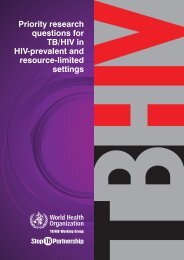
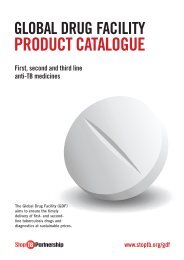
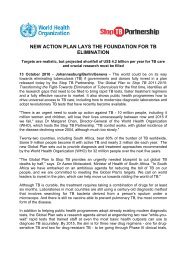
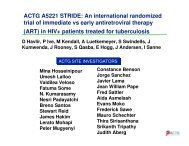
![Global Drug Facility Annual Report 2011 [.pdf] - Stop TB Partnership](https://img.yumpu.com/26788745/1/184x260/global-drug-facility-annual-report-2011-pdf-stop-tb-partnership.jpg?quality=85)

![Concept note on national stop TB partnership [.pdf]](https://img.yumpu.com/26788741/1/184x260/concept-note-on-national-stop-tb-partnership-pdf.jpg?quality=85)
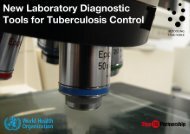

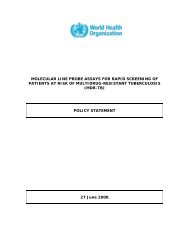
![2005 and Challenges for 2006 - 2015 [.pdf] - Stop TB Partnership](https://img.yumpu.com/26788674/1/190x245/2005-and-challenges-for-2006-2015-pdf-stop-tb-partnership.jpg?quality=85)
![Brochure (French) [.pdf] - Stop TB Partnership](https://img.yumpu.com/17234792/1/190x91/brochure-french-pdf-stop-tb-partnership.jpg?quality=85)

